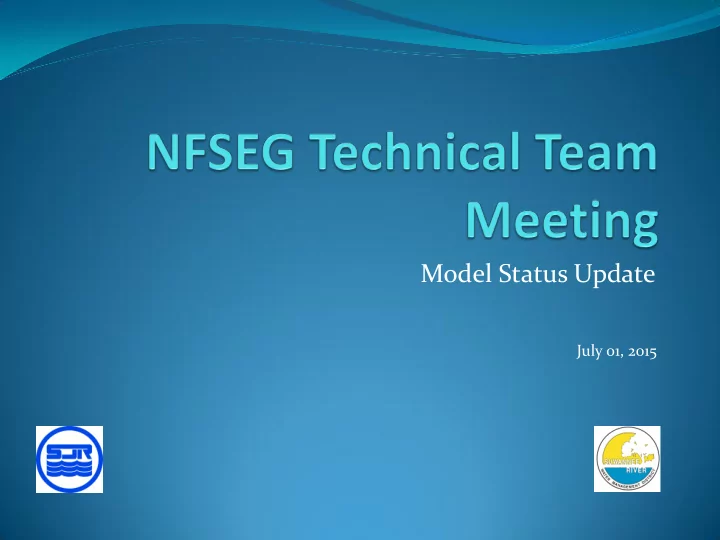

Model Status Update July 01, 2015
Agenda Purpose Model Development Update Model Calibration Status Next Steps Schedule Public Input
Purpose Inform stakeholders on status of model development Provide more detailed information on some of the model components Discuss next steps and timeline
Core Team Members Lead Groundwater Modelers Fatih Gordu, PE and Douglas Durden, PE (SJRWMD) Trey Grubbs (SRWMD) Lead Surface Water Modeler Tim Cera, PE (SJRWMD) PEST Calibration Expert John Doherty, PhD (Developer of PEST - Watermark Numerical Computing Pty. Ltd.)
Model Overview About 60,000 square miles (Probably largest gw model in the US) 5 times larger than NEF 6 times larger than ECFT 11 times larger than NCF MODFLOW-NWT 2500x2500 ft grid 7 layers HSPF models Steady-state calibration (2001 and 2009)
Model Development Update Water Use Data Updates Ag water use updates Technical team comments SWFWMD Comments Recharge Package HSPF/MODFLOW Interaction
Water Use Data Region PS/CII/Rec DSS AG Estimated by SJRWMD using parcel SJRWMD/SRWMD/SWFWMD Permit SJRWMD/SRWMD/SWFWMD Permit data and well construction Database Database database and SWFWMD Database FL Water Use Estimated by Balmoral Group using AFSIRS, USGS estimates and Metered/Reported water use Estimated by GIS Associates GA Water Estimated by Balmoral Group using Provided by USGS using Census blocks and USGS Use AFSIRS and USGS estimates estimates Estimated by GIS Associates SC Water Estimated by GIS Associates using Estimated by Balmoral Group using using Census blocks and USGS Use Census blocks and USGS estimates AFSIRS and USGS estimates estimates
Water Use Summary (MGD) (Draft – subject to change) Year Region PS/CII/Rec DSS AG Total FL 604 86 213 902 2001 GA/SC 362 41 868 1272 Total 966 127 1081 2174 FL 554 86 212 853 2009 GA/SC 298 44 1076 1418 Total 852 131 1288 2270 FL 556 85 202 843 2010 GA/SC 302 44 810 1156 Total 858 129 1011 1999
Recharge Package – HSPF Models 54 USGS HUC 8 watersheds More than 1800 subbasins Rainfall and PET NLDAS (North American Land Data Assimilation System)
MODFLOW -HSPF Interaction Max ET rate for MODFLOW ET Package ( Remaining ET for Active groundwater) Recharge (AGWI + IGWI) Baseflow Sinks and Drainage Wells
HSPF MODIFICATIONS (Inactive Groundwater Storage Implementation to account for Groundwatershed ) AGWO + IGWO = BASEFLOW Plan View of Reaches Calibration-1 Calibration-4 AGWO-1 Cross-sectional View of IGWO Sub-Watersheds AGWO-2 AGWO-3 Closed Basin AGWO-4 AGWS-C AGWS-1 AGWS-2 Watershed A Watershed B AGWS-3 AGWS-4 Sink IGWI-C IGWI-1 IGWI-2 IGWI-3 IGWI-4 IGWS
ModelCalibration Status Model Initialization/Testing PEST (Parameter Estimation Tool) Calibration Process Observation Groups Parameters Groups
Model Initialization/Testing Testing Model Conceptualization Addressing model convergence issues Testing range of parameters Gaining more insight on groundwater flow system Developing information for PEST calibration Getting input from SWFWMD
PEST CALIBRATION Task 1 –Setup Observation Groups Groundwater Vertical Head Horizontal Head Temporal Head Spring flows Baseflows Wetting Penalty Levels Differences Differences Differences Task 2 – Setup Calibration Parameters Hydraulic Conductivities Spring (GHB)Conductance River/Lake Conductance Recharge Task 3 – Setup PEST Run Files Control files Template files Instruction files Task 4 – PEST Runs Review Update Rerun Task 5 – Peer Review Initial Review Final Review
How does PEST work? Develop Parameter Sensitivities Compare Sim Read Output with ObsValues If Reached Min Run NFSEG Calculate START FINISH (Modflow) SSR Estimate Update Input New Set of Files Parameters SSR: Sum of squared residuals
Observation Groups Observed Water Levels Vertical Head Differences (SAS/UFA and UFA/LFA) Horizontal Head Differences Temporal Head Differences (2009 – 2001) Springflows Baseflows (By segment and total) Wetting penalty Lake Leakages APT Transmissivities
Parameter Groups Hydraulic Conductivities (Pilot Points) Spring Conductances River/Lake Conductances Recharge Multipliers
Calibration Target Statistics (From Model Conceptualization Report)
Next Steps Complete Initial PEST Calibration (2001 and 2009) Initiate transient calibration process
NFSEG PEST CALIBRATION SCHEDULE Identify Observation and 3/30/2015 - 5/4/2015 Parameter Groups Setup Observation Groups 4/6/2015 - 6/1/2015 Setup Calibration Parameters 4/13/2015 - 6/15/2015 Prepare PEST Run files 6/8/2015 - 7/15/2015 PEST Runs 7/16/2015 - 8/30/2015 Finalize Initial PEST Calibration 8/17/2015 - 9/6/2015 8/3/2015 - Peer Review 9/30/2015 2015 Mar Apr May Jun Jul Aug Sep Today
Schedule End of September 2015 – Initial PEST Calibration completed
Public Input
ADDITIONAL SLIDES (AS NEEDED)
Model Layers
Lateral Boundary Conditions
Springs and Rivers GHB and River Package SRWMD HEC-RAS model St. Johns River SW Model
Calibration Target Wells Data Filling Types (2001, 2009 , 2010) (1) Original data > 6 months (2) Filled data > 6 months (3) Filled second data > 6 months (4) PCA data > 6 months (5) Any data < 6 months
ET Extinction Depth (Modified from Shah et al., 2007) Extinction Depths (ft) under Forest Land Cover Soil Type Hydric Partly hydric Non-hydric sand 4.9 9.8 14.8 loamy sand 5.6 10.5 15.4 sandy loam 7.5 12.5 17.4 sandy clay loam 9.8 14.8 19.7 sandy clay 10.2 15.1 20.0 loam 12.0 16.9 21.8 silty clay 14.3 19.2 24.1 clay loam 16.6 21.5 26.4 silt loam 16.9 21.8 26.9 silt 17.4 22.3 27.2 silty clay loam 18.0 23.0 27.9 clay 23.6 28.5 33.5 Extinction Depths (ft) under Grass Land Cover Soil Type Hydric Partly hydric Non-hydric sand 4.9 6.6 8.2 loamy sand 5.6 7.2 8.9 sandy loam 7.5 9.2 10.8 sandy clay loam 9.8 11.5 13.1 sandy clay 10.2 11.8 13.5 loam 12.0 13.6 15.3 silty clay 14.3 15.9 17.6 clay loam 16.6 18.2 19.8 silt loam 16.9 18.5 20.3 silt 17.4 19.0 20.7 silty clay loam 18.0 19.7 21.3 clay 23.6 25.3 26.9
Well Package AE wells (Permitted Wells) Well coordinates are known Source aquifer is only one aquifer MNW package (Permitted Wells) Well coordinates are known Source aquifer is more than one aquifer and/or not identified in the database BC wells (Estimated water use) Well coordinates are unknown Water use estimated
HSPF Closed Basins Closed No other outlet Confined or semi-confined High recharge rate Closed with Sink or Drainage Wells Known sink or drainage wells in basin Closed with Transfer Down Gradient Unconfined All water expected to be active groundwater
Recommend
More recommend